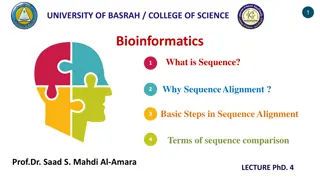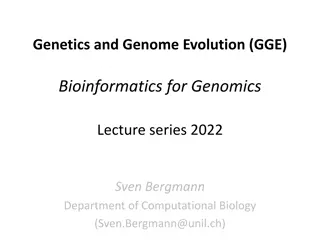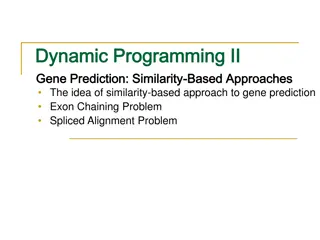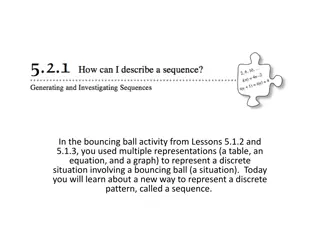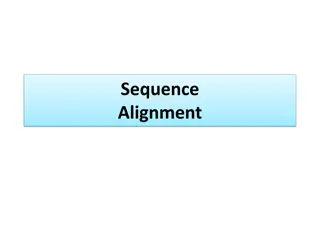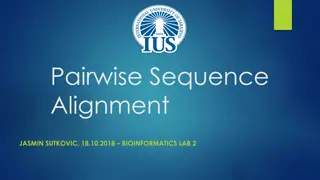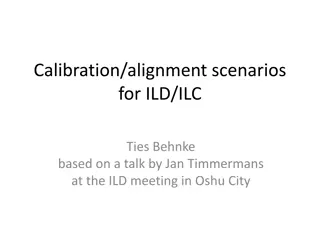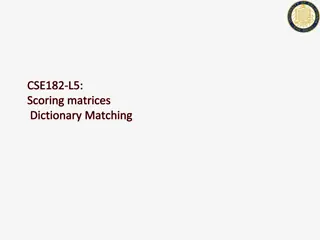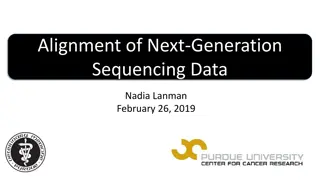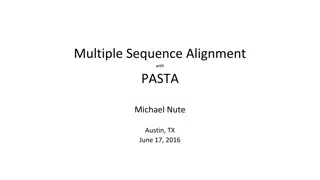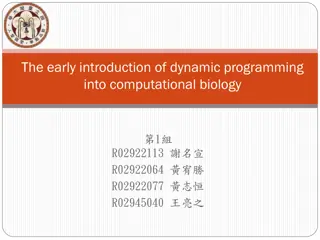Sequence Alignment Methods in Bioinformatics
Sequence alignment is crucial in bioinformatics for identifying similarities between DNA, RNA, or protein sequences. Methods like Pairwise Alignment and Multiple Sequence Alignment help in recognizing functional, structural, and evolutionary relationships among sequences. The Needleman-Wunsch algorithm for global alignment and Smith-Waterman algorithm for local alignment are commonly used approaches. Scoring the alignment involves rewarding matches, penalizing mismatches, and managing spaces to determine the best alignment.
Download Presentation

Please find below an Image/Link to download the presentation.
The content on the website is provided AS IS for your information and personal use only. It may not be sold, licensed, or shared on other websites without obtaining consent from the author.If you encounter any issues during the download, it is possible that the publisher has removed the file from their server.
You are allowed to download the files provided on this website for personal or commercial use, subject to the condition that they are used lawfully. All files are the property of their respective owners.
The content on the website is provided AS IS for your information and personal use only. It may not be sold, licensed, or shared on other websites without obtaining consent from the author.
E N D
Presentation Transcript
Sequence Alignment Lecture 5 Department of CSE, DIU
CONTENTS 1. Sequence Alignment -Why align sequences 2. Sequence Alignment Methods -Pairwise Alignment -Multiple Sequence Alignment 3. Pairwise Sequence Alignment Methods -Global Alignment (Needleman-Wunsch) -Local Alignment (Smith-Waterman)
1. Sequence Alignment Why and how align sequences
Sequence Alignment A way of arranging the sequences of DNA, RNA, or CTGTCG-CTGCACG protein to identify regions of similarity that may be a consequence of functional, structural, or -TGC-CG-TG---- evolutionary relationships between the sequences
Whyalignsequences? Useful fordiscovering Functional Structural and Evolutionary relationship For example Tofindwhether two(ormore)genesorproteins are evolutionarily related toeach other Two proteins with similar sequences will probably be structurally or functionally similar
2. Sequence Alignment Methods Pairwise and Multiple
Pairwise Sequence Alignment A pair of sequences as input Align them in such a way that, for that particular alignment the assumed region of similarity produces higher score than all the other alignments CTGTCGCTGCACG-- -------TGC-CGTG Methods -Global Alignment (Needleman-Wunsch) -Local Alignment (Smith-Waterman)
Pairwise Sequence Alignment Idea: Display one sequence above another with spaces inserted in both to reveal similarity A: C A T - T C A - C | | B: C - T C G C A G C | | |
Scoringthealignment Reward for matches: 10 Mismatch penalty: Space penalty: 2 5 C T G T C G C T G C - T G C C G T G - -5 10 10 -2 -5 -2 -5 -5 10 10 -5
OptimumAlignment The score of an alignment is a measure of its quality Optimum alignment problem: Given a pair of sequences X and Y, find an alignment (global or local) with maximum score The similarity between X and Y, denoted sim(X,Y), is the maximum score of an alignment of X and Y
Multiple Sequence Alignment Three or more than three sequences as input Align all the sequences altogether in such a manner that the alignment produces highest score
3. Pairwise Sequence Alignment Global and Local methods
GlobalVSLocal Global Alignment Attempts to align the maximum of the entire sequence Suitable for similar and equal length sequences CTGTCG-CTGCACG CTGTCGCTGCACG-- -------TGC-CGTG -TGC-CG-TG---- Global alignment Local alignment Local Alignment Gathers islands of matches Stretches of sequences with highest density of matches are aligned Suitable for partially similar, different length and conserved region containing sequences
Global Alignment (Needleman-Wunsch) Trace back 3 Major Steps -Start from Cell (Row, Col) -Go back up to Cell (0,0) -Create 2D Matrix -Trace back -Final Alignment Create 2D Matrix -Row x Col 2D matrix draw (Row , Col size of seq1 and seq2 respectively) -Place 2 seqs as Row and Column Header -Cell (0,0) = 0 -Cell (0,1) to Cell (0,Column) and Cell (1,0) to Cell (Row,0) value = delete gap value from previous cell value -For other cell values, follow equation in (1) Final Alignment -Start from Cell (Row, Col) -If then, place character in both seq -If or then character in start seq& gap in end seq
Global Alignment (Needleman-Wunsch) -Example -AGC A -2 1 -1 -3 -5 G -4 -6 -1 -3 0 -2 -4 C Input -seq1 = AAAC -seq2 = AGC AAAC 0 Scoring Scheme Final Alignment A A A C -2 -4 -6 -8 (x, x) = 1 (Match) (x,-) = -2 (Gap) (x, y) = -1 (Mis match) -2 -1 -1 Eq. 1: Cell Value
Local Alignment (Smith-Waterman) Trace back 3 Major Steps -Start from each Cell which has the maximum value in the entire matrix -Go back up to the Cell where first time 0 occurs -Create 2D Matrix -Trace back -Final Alignment Create 2D Matrix -Row x Col 2D matrix draw (Row , Col size of seq1 and seq2 respectively) -Place 2 seqs as Row and Column Header -First Row, First Column all value = 0 -For other cell values, follow equation in (2) Final Alignment -Start from each Cell with max value -If then, place character in both seq -If or then character in start seq& gap in end seq
Local Alignment (Smith-Waterman) -Example -AAG A 0 1 1 1 0 A 0 1 2 2 0 G 0 0 0 1 1 Input -seq1 = AAAC -seq2 = AAG AAAC 0 0 0 0 0 Scoring Scheme Final Alignment A A A C (x, x) = 1 (Match) (x,-) = -2 (Gap) (x, y) = -1 (Mis match) Eq. 2: Cell Value



